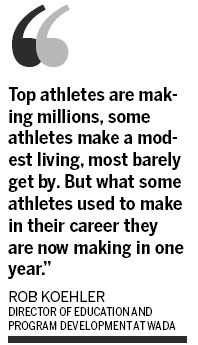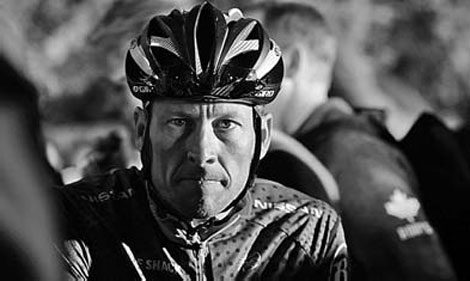Darker side to glamor of global sports
Updated: 2013-04-03 05:32
By Reuters in London (China Daily)
|
|||||||||||
|
A spate of troubling stories - including Lance Armstrong's doping scandal - in the first quarter of 2013 show an altogether darker and more disturbing side to the glamorous, multi-billion-dollar global sport industry. Mike Hutchings / Reuters |
Doping's shadow has grown considerably this year
Unprecedented levels of skill, intensity and endurance have transformed global sports into spectacular mass entertainment and handsomely rewarded its leading exponents.
Now that the euphoria of last year's acclaimed London Olympics has dissipated, however, a spate of troubling stories in the first quarter of 2013 show an altogether darker and more disturbing side to a glamorous, multi-billion-dollar industry.
In January, American cyclist Lance Armstrong admitted in a television interview that he had doped before each of his record seven Tour de France victories.
His confession after years of denial followed the United States Anti-Doping Agency's decision to strip him of the title and accuse him of being at the center of the "most sophisticated, professionalized and successful doping program that sport has ever seen".
A report from Australia's top criminal intelligence unit linked doping in sports with money-laundering and match-fixing after a year-long investigation. Six leading rugby league clubs, from one of the country's four football codes in a sports-obsessed nation, confirmed they were under scrutiny.
And Spanish doctor Eufemiano Fuentes, on trial in Madrid for allegedly running a doping ring in cycling, said in his opening testimony that he also had clients in soccer, tennis, athletics and boxing.
Fuentes, who said outside the court this month that he might be willing to co-operate with anti-doping authorities, is appearing in court almost seven years after steroids and blood bags were seized in an investigation code-named Operation Puerto.
"The same people who are trafficking in steroids and encouraging athletes to cheat by doping are the ones who are engaged in illegal betting," said World Anti-Doping Agency Director General David Howman.

"This is essentially money-laundering, bribery and corruption in relation to match-fixing and spot-fixing."
At a WADA media symposium in London in February, Howman said at least 25 percent of international sports was controlled by the underworld.
"The black markets supply a lot of pharmaceutical products before they are out on the white market," he said. "That's run by the criminal underworld, so a lot of the pharmaceutical stuff comes out in that way."
Rob Koehler, the director of education and program development at WADA, told an anti-doping conference in London this month the drug problem in sports reflected the problems of society as a whole.
"We are always trying to push the limit," he said. "Adults are cheating. Students are cheating - in fact, they think they are smart if they don't get caught."
Koehler said one percent of the population as a whole was rich while the middle class was shrinking and the lower class growing. The position was similar in sports.
"Top athletes are making millions, some athletes make a modest living, most barely get by," he said. "But what some athletes used to make in their career they are now making in one year."
Doping's black heartland has traditionally been in the speed and strength sports of track and field, weightlifting and cycling.
But it has also become increasingly apparent that the nature of ball sports, which rely on a unique set of skills peculiar to their disciplines, has changed.
Baseball, with its explosion of home runs in the 1990s, is an obvious example, and this year slugger Barry Bonds, the record holder for home runs, and pitcher Roger Clemens, a seven-time Cy Young winner, were not elected to the Hall of Fame.
The pair, appearing on the ballot for the first time after waiting five years following their retirements, were linked with performance-enhancing drugs in the Mitchell Report, which detailed widespread doping in the sport.
Baseball is similar in nature to Twenty20 cricket, where both strength and technique are necessary to repeatedly clear the boundaries. Rugby union players, who used to be a mixture of the big and the powerful and the small and the speedy, are now uniformly bulked up.
Tennis, as the five-set marathons now common in the men's game demonstrate, demands sustained power and endurance to an extent once unimaginable.
Even golfers, as the modern breed of players headed by Tiger Woods demonstrates, are now athletes working out in the gym as well as frequenting the driving range.
In England, the Football Association reacted to concerns expressed by Arsenal manager Arsene Wenger about the possible use of EPO by announcing it would bring in testing for the blood booster, which was introduced into cycling in the 1990s.
"We have had some players come to us at Arsenal from other clubs abroad and their red blood cell count has been abnormally high. That kind of thing makes you wonder," Wenger said.
Wenger also called for blood testing in soccer, adding: "I don't think we do enough. It is very difficult for me to believe that you have 740 players in the World Cup and you come out with zero problems."
(China Daily 04/03/2013 page23)
Today's Top News
Police continue manhunt for 2nd bombing suspect
H7N9 flu transmission studied
8% growth predicted for Q2
Nuke reactor gets foreign contract
First couple on Time's list of most influential
'Green' awareness levels drop in Beijing
Palace Museum spruces up
Trading channels 'need to broaden'
Hot Topics
Lunar probe , China growth forecasts, Emission rules get tougher, China seen through 'colored lens', International board,
Editor's Picks

|

|

|

|

|

|






